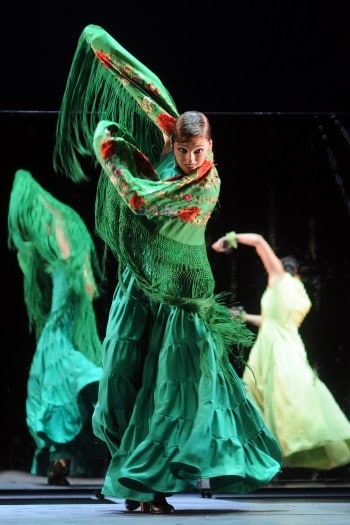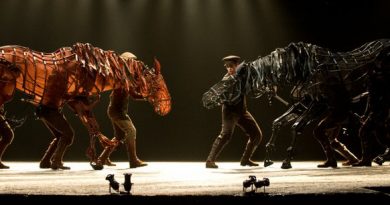Adelaide Festival: Flamenco Hoy

For most South Australians an evening of flamenco – and we have fine singers, guitarists and dancers here with regular contact with Spain – is a bare stage, some guitars, and percussion and a handful of dancers male and female. They perform a sequence of dances, solos and ensembles.
Flamenco Hoy, flamenco today, created by the eminent film maker Carlos Saura, takes the expected ingredients of an immensely high level of skill and recreates flamenco as if it were a Masterchef challenge.
His intention is signalled in the opening seconds as a projected Goya like scene of traditional Spanish festivity fades to reveal a stage of projection screens and coloured lights. Saura gives theatrical context to individual numbers, and with the work of his choreographers and principal dancers the chunky Raul Estevez and the spunky Valeriano Panos blends flamenco stylings and rhythmic complexities with other dance forms, most notably in the first act finale. Here the dancers assemble in a rehearsal room and perform a straightforward almost standard classical ballet routine to the music of Boccherini. Barely a trace of flamenco is visible.
The first routine shows of the impressive physiques of his male dancers and leads into a solo by Panos, in white silk, performing a solo which left many women and some of the men in the audience afraid they might be pregnant. Of course, flamenco isn‘t (just) about sex, though it certainly celebrates the body. It’s about a whole-hearted self-display and commitment to the music and the story. The Spanish have a word for it, ‘Duende’. You don’t need to attempt an English translation, just witness the power and the passion on stage.
Elsewhere Saura takes the trappings of flamenco and refocuses them. Castanets barely feature except in a sensuous trio for three women, one of whom performs with a long fringed scarf, before the motif occurs later in a group routine. There are no mantillas held in place by elaborate combs. The tight-waisted low-cut and flounced dresses of traditional flamenco are replaced with flounced skirts with trains of exaggerated length. In one brief sequence two women cross the stage, with metres of red or white silk flowing behind them. They entwine gently and pose their bodies rising from the waves of fabric gathered around their feet.
The music is of an impeccable standard even if the guitar solos are aggressively amplified. There are three singers whose expressive voices don’t require surtitles to express the depth of their feelings. The men are Blas Cordoba and Israel. The woman is Sandra Carrasco whose hair is so long, fallen like a silken curtain across her face that you feel she could fulfil TS Eliot’s vision and draw her long dark hair out tight and fiddle gypsy music on the strings. The roughness and spontaneity of flamenco has been smoothed and rehearsed, though many routines, especially from the principal dancers are obviously, like jazz, improvised around a predetermined focus.
It’s likely that Sauras’ approach to flamenco won’t or hasn’t found favour with traditionalists in Spain or South Australia. Dance traditions are closely guarded, with deviation denounced as choreographic heresy. Dance needs to breathe and develop and Saura adds notes of Broadway, ballet, brothels to the national art of his homeland.
The show is as tight as a matador’s suit, as seductive and dangerous as well. It’s a hell of a lot sexier than Riverdance.

